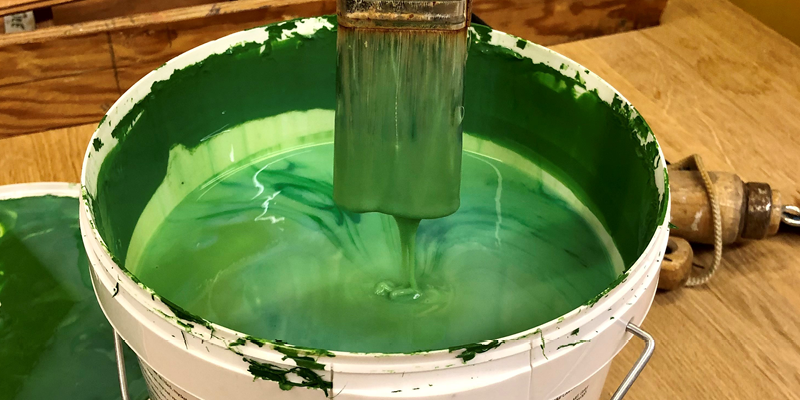
At Målbar, we often conduct our own studies when we find that accessible data are lacking on different materials and processes. And in our attempt to measure more precisely on the different surface treatments, we have examined the contents of glue and paint as well as their application. The purpose has been to learn more about the impact of coating including which specific ingredients in paint and glue bear the main climate emissions.
The complexity of glues and paints

Paints and lacquers contain many ingredients. The main ones are
- solvents, that ensure the contents to mix;
- binders that make the ingredients stick together after application and
- pigments that give the paint its color
Then there are filling materials that influence the texture and increase the volume making the paint cheaper and easier to apply. Other additives may be chemicals to make the paints flame resistant, water resistant, weather resistant etc.
The industries
Studying the glues, we had a close cooperation with a glue manufacturer, that gladly shared their recipes with us and was very interested in getting our results on the climate impact of their products.
On the other hand, the paint industry has shown to be much more closed since most companies keep their recipes a secret. It has not been possible for us to receive any primary data from companies since they are very reluctant to share anything because of the competition on the market. This also means that it is very limited what you can find online and in the literature. Some of the recipes we did find are from the past century. So, it has been a huge challenge to find valid, detailed, and recent data on paint.
The emissions
In glues, the ingredients are the main emission contributors and not the production methods. In the furniture sector, there are mainly two primary kinds of glue based on either melamine or urea. Both these ingredients have a quite high carbon footprint.

In paints it is also the raw materials that bear the main impact, but not one ingredient stands out. The pigment for white color has a very high footprint, so transparent paint often has a lower footprint. However, it also depends very much on the binder – they differ a lot. Because there are so many different kinds of paint, the complexity is very high making it difficult to find a clear pattern. Transparent and water-based paints overall may be claimed to have the lowest footprint and also the density of a paint can give a good hint on its impact. In many cases, it applies that the lower the density, the lower the carbon footprint.
It has also been difficult to find out how much pigment is needed to make a color as it depends on the type of pigment. You need way less pigments for a black paint than for a white paint. So, pigments might have a high impact but then the footprint depends on how much you use for a color, meaning that different colors otherwise based on the same recipe can have different footprints.
We also investigated the application of paint, and this has a significant impact on the climate emissions. If you apply the paint with a brush or dip your product in paint, there is limited waste. But if you spray it, large amounts of paint do not hit and end up on the surface and is discarded as waste. Sometimes, more than half of the paint goes somewhere else than the product.
We will continue to push for data on the paint area and continuously expand our calculations for surface treatments. Furthermore, we wish to study the toxicity and ecotoxicity of the many different ingredients in coating products and make sensitivity analysis.
The impact on green transitioning
From our perspective, it is sad that so many industries are so closed and secretive about their recipes, because it prevents organizations like us to conduct valid studies on the impact of products and materials. Furthermore, it is preventing or slowing the industry from competing on sustainability and thereby not developing greener solutions.
The glue industry, on the other hand, seems much more open and eager to learn about how they can reduce their climate impact.
Finally, we did find very few studies on sustainable alternatives for ingredients in paint. These studies are mostly focused on biobased ingredients replacing fossil based. It could be paints or oils based on linseed oil or other biobased binders. Linseed oil binders are a good choice if one would like to ensure that the paint or oil is biodegradable in nature and hereby not contributing to microplastic from outside products. The climate effect is not very different from fossil based paint though so we hope that some of the other bio-alternatives prove more climate efficient.
The validity of the data in our tool
As usual, we have a conservative evaluation of the surface treatments in our tool. This means that we use a paint with a fairly high emitting mix of pigments and binders, and we assume that fossil-based heat is used for curing or drying the paint. The emissions from heat can be quite significant because of the tendency in the industry to speed up production processes, by turning up the heat. In our tool, it is possible to choose biobased or green energy as the source of heat.


